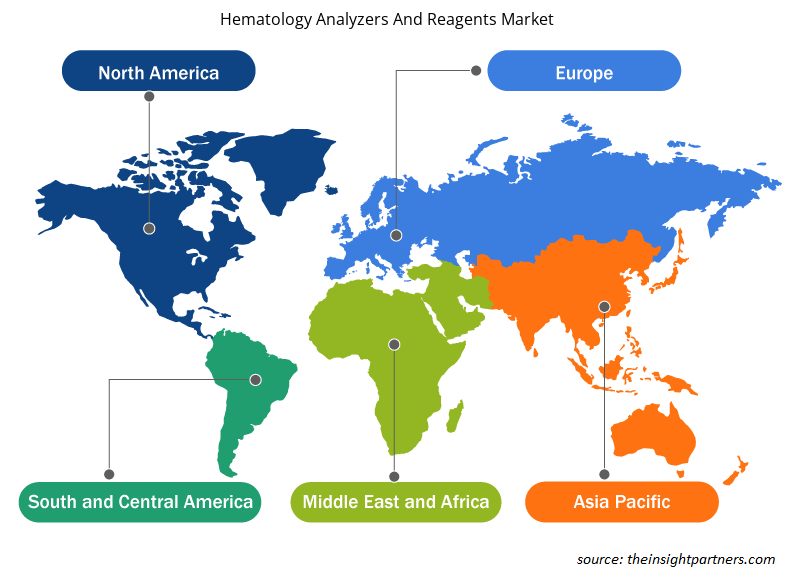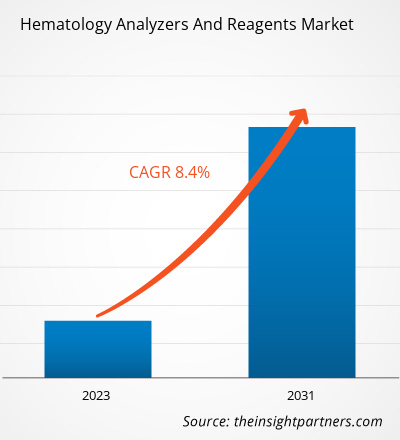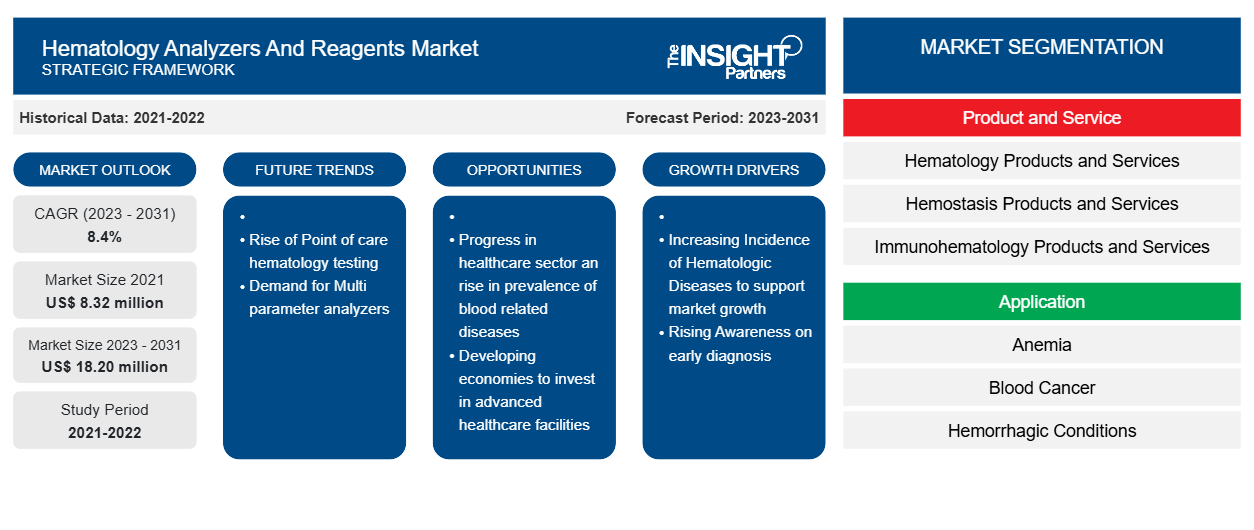تم تقدير حجم سوق أجهزة تحليل الدم والكواشف بنحو 8.32 مليون دولار أمريكي في عام 2021 وXX مليون دولار أمريكي في عام 2023 ومن المتوقع أن يصل إلى 18.20 مليون دولار أمريكي بحلول عام 2031؛ ومن المتوقع أن يسجل معدل نمو سنوي مركب بنسبة 8.4٪ حتى عام 2031. ومن المرجح أن يظل التبني المتزايد لأجهزة نقطة الرعاية الذكية من الاتجاهات الرئيسية في سوق أجهزة تحليل الدم والكواشف.
تحليل سوق أجهزة تحليل الدم والكواشف
إن اللاعبين العاملين في سوق أجهزة تحليل الدم والكواشف تنافسيون للغاية وقد قدموا منتجات وكواشف جديدة. على سبيل المثال، في يناير 2024، أطلقت شركة HORIBA Medical أحدث منصة تحليل الدم الآلية عالية الإنتاجية HELO 2.0. تمت الموافقة على المنصة من قبل اللائحة الأوروبية لأجهزة التشخيص المختبري (IVDR) CE- وتنتظر حاليًا موافقة إدارة الغذاء والدواء الأمريكية (FDA). يعد HELO 2.0 الجيل التالي من مجموعة تحليل الدم المتطورة وقد تم تطويره بالتشاور مع العملاء لتلبية جميع احتياجات تحليل الدم الآلية بالكامل عالية الإنتاجية. يوفر HELO 2.0 حلاً معياريًا لتحليل الدم عالي المرونة والكفاءة، والذي يمكن توسيعه وتكوينه بالكامل ليناسب الاحتياجات المتنوعة للمختبرات المتوسطة إلى الكبيرة الحجم. وبالمثل، في مايو 2023، أطلقت شركة Siemens Healthineers حلين لاختبارات الدم عالية الحجم: جهاز Atellica HEMA 570 Analyzer وجهاز Atellica HEMA 580 Analyzer. إن قدرة المختبر على مراجعة وإصدار نتائج اختبارات المرضى بسرعة تعوقها الاستخدام الواسع لاختبار تعداد الدم الكامل ونقص الموظفين المتزايد. يوفر جهازا Atellica HEMA 570 وAtellica HEMA 580 Analyzers أتمتة وذكاء متكاملين لتحسين كفاءة سير العمل وإنتاج نتائج أسرع للمرضى. إن إطلاق مثل هذه المنتجات الجديدة يغذي نمو سوق أجهزة تحليل الدم والكواشف.
نظرة عامة على سوق أجهزة تحليل الدم والكواشف
يعود نمو سوق أجهزة تحليل الدم والكواشف إلى زيادة عدد أمراض الدم والتقدم التكنولوجي في أجهزة تحليل الدم. ومع ذلك، من المرجح أن تعيق الأسعار المرتفعة للأنظمة عالية المستوى نمو السوق.
يتم تقسيم سوق أجهزة تحليل الدم والكواشف العالمية حسب المنطقة إلى أمريكا الشمالية وأوروبا وآسيا والمحيط الهادئ والشرق الأوسط وأفريقيا وأمريكا الجنوبية والوسطى. تعد منطقة أمريكا الشمالية أكبر مساهم ومنطقة آسيا والمحيط الهادئ هي أسرع سوق نموًا لأجهزة تحليل الدم والكواشف. من المتوقع أن يكون نمو سوق أجهزة تحليل الدم والكواشف له أكبر حصة في الولايات المتحدة. ومن المتوقع أن ينمو نمو السوق في الولايات المتحدة بسبب العدد المتزايد من إجراءات فحص الدم، وانتشار أمراض الدم، وارتفاع عدد مراكز التشخيص وفحص الدم ، والوصول إلى البنية التحتية المتطورة وغيرها.
قم بتخصيص هذا التقرير ليناسب متطلباتك
ستحصل على تخصيص لأي تقرير - مجانًا - بما في ذلك أجزاء من هذا التقرير، أو تحليل على مستوى الدولة، وحزمة بيانات Excel، بالإضافة إلى الاستفادة من العروض والخصومات الرائعة للشركات الناشئة والجامعات
- احصل على أهم اتجاهات السوق الرئيسية لهذا التقرير.ستتضمن هذه العينة المجانية تحليلاً للبيانات، بدءًا من اتجاهات السوق وحتى التقديرات والتوقعات.
محركات وفرص سوق أجهزة تحليل الدم والكواشف
ارتفاع معدل الإصابة بأمراض الدم لصالح السوق
وفقًا لمراكز السيطرة على الأمراض والوقاية منها (CDC)، يولد ما يقرب من 12 من كل 100000 ذكر في الولايات المتحدة و400 ولد مصابين بالهيموفيليا أ كل عام. علاوة على ذلك، أفادت جمعية اللوكيميا والليمفوما (LLS) أنه في الولايات المتحدة، يتم تشخيص شخص واحد بالليمفوما أو اللوكيميا أو المايلوما كل 3 دقائق. في عام 2023، من المتوقع تشخيص ما يقدر بنحو 184720 شخصًا في الولايات المتحدة باللوكيميا أو الليمفوما أو المايلوما. علاوة على ذلك، من المتوقع أن تشكل الحالات الجديدة من الليمفوما وسرطان الدم والليمفوما 9.4٪ من 1958310 حالة سرطان جديدة سيتم تشخيصها في الولايات المتحدة في عام 2023. يؤدي الانتشار المتزايد لأمراض الدم إلى زيادة الطلب على نقل الدم وكذلك تعداد خلايا الدم لمراقبة الحالة الطبيعية، مما يؤدي إلى تصعيد الطلب على أجهزة تحليل الدم والكواشف. إن الارتفاع المتزايد في حالات الإصابة بأمراض الدم يعمل على تعزيز نمو سوق أجهزة تحليل الدم والكواشف.
التقدم في قطاعات الرعاية الصحية وارتفاع معدل انتشار الأمراض المرتبطة بالدم في الاقتصادات الناشئة – فرصة في سوق أجهزة تحليل الدم والكواشف
ترتفع معدلات الإصابة بأمراض الدم بشكل كبير في البلدان النامية بسبب التحول في نمط حياة السكان. علاوة على ذلك، فإن الانتشار المتزايد للحالات الصحية الأخرى بسبب انخفاض الأنشطة البدنية وزيادة مستويات التوتر يساهم أيضًا في ارتفاع حالات الاضطرابات الدموية في هذه البلدان. تسعى الدول النامية جاهدة لتحقيق تقدم كبير في مرافقها وخدماتها الصحية. على سبيل المثال، تعد منظمة الهيموفيليا في الهند (HFI) منظمة غير ربحية عملت بشكل وثيق مع الاتحاد العالمي للهيموفيليا (WFH) لزيادة الوعي بشأن الهيموفيليا والعلاجات الميسورة التكلفة المتاحة لنفس المرض بالإضافة إلى تحسين تشخيص المرض. علاوة على ذلك، يسعى فريق RED LAPI المحترف إلى المساهمة وتحسين تشخيص وعلاج الهيموفيليا في أمريكا اللاتينية. توفر مثل هذه التطورات في سوق أجهزة تحليل الدم والكواشف في الدول النامية في منطقة آسيا والمحيط الهادئ والشرق الأوسط وأفريقيا وأمريكا اللاتينية فرصًا للنمو المستقبلي للاعبين في السوق.
تقرير تحليل تجزئة سوق أجهزة تحليل الدم والكواشف
القطاعات الرئيسية التي ساهمت في اشتقاق تحليل سوق أجهزة تحليل الدم والكواشف هي المنتج والخدمة والسبب والتطبيق والمستخدم النهائي.
- بناءً على المنتج والخدمة، يتم تقسيم سوق أجهزة تحليل الدم والكواشف إلى منتجات وخدمات أمراض الدم، ومنتجات وخدمات وقف النزيف، ومنتجات وخدمات المناعة الدموية. يتم تقسيم منتجات وخدمات أمراض الدم بشكل أكبر إلى أدوات وكواشف ومواد استهلاكية وخدمات. وبالمثل، يتم تقسيم شريحة منتجات وخدمات وقف النزيف إلى أدوات وكواشف ومواد استهلاكية وخدمات. يتم تقسيم شريحة منتجات وخدمات المناعة الدموية في سوق أجهزة تحليل الدم والكواشف أيضًا إلى أدوات وكواشف ومواد استهلاكية وخدمات. احتلت شريحة منتجات وخدمات المناعة الدموية حصة سوقية أكبر في عام 2023.
- من حيث التطبيق، يتم تقسيم السوق إلى فقر الدم، وسرطان الدم، والحالات النزفية، والحالات المرتبطة بالعدوى، والحالات المرتبطة بالجهاز المناعي ، وتطبيقات أخرى. احتل قطاع فقر الدم الحصة الأكبر من السوق في عام 2023.
- من حيث المستخدم النهائي، يتم تقسيم السوق إلى مختبرات المستشفيات ومقدمي الخدمات التجارية والمختبرات المرجعية الحكومية والمعاهد البحثية والأكاديمية. هيمن قطاع مختبرات المستشفيات على السوق في عام 2023.
تحليل حصة سوق أجهزة تحليل الدم والكواشف حسب المنطقة الجغرافية
ينقسم النطاق الجغرافي لتقرير سوق أجهزة تحليل الدم والكواشف بشكل أساسي إلى خمس مناطق: أمريكا الشمالية، ومنطقة آسيا والمحيط الهادئ، وأوروبا، والشرق الأوسط وأفريقيا، وأمريكا الجنوبية/أمريكا الجنوبية والوسطى.
في أمريكا الشمالية، تعد الولايات المتحدة أكبر سوق لتصنيع أجهزة تحليل الدم والكواشف. ويعود نمو السوق الأمريكية في المقام الأول إلى سيناريوهات البحث المواتية، والطلب المتزايد على الدم ومكونات الدم، والتبني الكبير لأجهزة تحليل الدم الآلية.
انتشار متزايد لاضطرابات الدم مثل اللوكيميا والهيموفيليا وفقر الدم في الولايات المتحدة. وتشير تقديرات الجمعية الأمريكية للسرطان لسرطان الدم في الولايات المتحدة بحلول عام 2024 إلى:
- حوالي 62770 حالة إصابة جديدة بسرطان الدم (بجميع أنواعه) و23670 حالة وفاة بسرطان الدم (بجميع أنواعه)
- حوالي 20,800 حالة جديدة من سرطان الدم النقوي الحاد (AML). معظمها بين البالغين.
- حوالي 11220 حالة وفاة بسبب سرطان الدم النخاعي الحاد. معظمها بين البالغين.
من المتوقع أن يكون الوعي المتزايد بالتشخيص المبكر بين المرضى أحد القوى الدافعة الرئيسية لسوق أجهزة تحليل الدم والكواشف. ومن المتوقع أن تنمو منطقة آسيا والمحيط الهادئ بأعلى معدل نمو سنوي مركب في السنوات القادمة.
رؤى إقليمية حول سوق أجهزة تحليل الدم والكواشف
لقد قام المحللون في Insight Partners بشرح الاتجاهات والعوامل الإقليمية المؤثرة على سوق أجهزة تحليل الدم والكواشف خلال فترة التوقعات بشكل شامل. يناقش هذا القسم أيضًا قطاعات سوق أجهزة تحليل الدم والكواشف والجغرافيا في جميع أنحاء أمريكا الشمالية وأوروبا ومنطقة آسيا والمحيط الهادئ والشرق الأوسط وأفريقيا وأمريكا الجنوبية والوسطى.

- احصل على البيانات الإقليمية المحددة لسوق أجهزة تحليل الدم والكواشف
نطاق تقرير سوق أجهزة تحليل الدم والكواشف
| سمة التقرير | تفاصيل |
|---|---|
| حجم السوق في عام 2021 | 8.32 مليون دولار أمريكي |
| حجم السوق بحلول عام 2031 | 18.20 مليون دولار أمريكي |
| معدل النمو السنوي المركب العالمي (2023 - 2031) | 8.4% |
| البيانات التاريخية | 2021-2022 |
| فترة التنبؤ | 2023-2031 |
| القطاعات المغطاة | حسب المنتج والخدمة
|
| المناطق والدول المغطاة | أمريكا الشمالية
|
| قادة السوق وملفات تعريف الشركات الرئيسية |
|
كثافة اللاعبين في سوق أجهزة تحليل الدم والكواشف: فهم تأثيرها على ديناميكيات الأعمال
يشهد سوق أجهزة تحليل الدم والكواشف نموًا سريعًا، مدفوعًا بالطلب المتزايد من المستخدم النهائي بسبب عوامل مثل تفضيلات المستهلك المتطورة والتقدم التكنولوجي والوعي الأكبر بفوائد المنتج. ومع ارتفاع الطلب، تعمل الشركات على توسيع عروضها والابتكار لتلبية احتياجات المستهلكين والاستفادة من الاتجاهات الناشئة، مما يؤدي إلى زيادة نمو السوق.
تشير كثافة اللاعبين في السوق إلى توزيع الشركات أو المؤسسات العاملة في سوق أو صناعة معينة. وهي تشير إلى عدد المنافسين (اللاعبين في السوق) الموجودين في مساحة سوق معينة نسبة إلى حجمها أو قيمتها السوقية الإجمالية.
الشركات الرئيسية العاملة في سوق أجهزة تحليل الدم والكواشف هي:
- الحلول التشخيصية السريرية، المحدودة
- شركة شنتشن ميندراي للإلكترونيات الطبية الحيوية المحدودة
- داناهر
- مختبرات بيو-راد المحدودة
- أبوت
- دياترون
إخلاء المسؤولية : الشركات المذكورة أعلاه ليست مرتبة بأي ترتيب معين.

- احصل على نظرة عامة على أفضل اللاعبين الرئيسيين في سوق أجهزة تحليل الدم والكواشف
أخبار السوق والتطورات الأخيرة لأجهزة تحليل الدم والكواشف
يتم تقييم سوق أجهزة تحليل الدم والكواشف من خلال جمع البيانات النوعية والكمية بعد البحث الأولي والثانوي، والذي يتضمن منشورات الشركات المهمة وبيانات الجمعيات وقواعد البيانات. فيما يلي قائمة بالتطورات في سوق أجهزة تحليل الدم والكواشف والاستراتيجيات:
- أطلقت شركة هوريبا ميديكال منتجات جديدة ضمن مجموعة منتجاتها Yumizen لتحليل الدم. قدمت الشركة جهازين صغيرين لتحليل الدم، Yumizen H500 وYumizen H550، واللذان يوفران أداءً محسنًا وميزات جديدة وفوائد متزايدة. تم تصميم هذين الجهازين لتقديم تقرير سريع وشامل لتحليل الدم مع معدل إنتاج مرتفع يبلغ 60 اختبارًا في الساعة، واستقلالية 40 أنبوبًا مع التحميل المستمر، والوضع اليدوي العاجل، وأوضاع التحليل المتعددة وأخذ العينات لتشغيل العينات. (المصدر: هوريبا ميديكال، 2022)
- أطلقت شركة Mindray سلسلة ثورية من أجهزة تحليل الدم، وهي سلسلة BC-700، والتي تتضمن كل من اختبارات تعداد الدم الكامل (CBC) ومعدل ترسيب كريات الدم الحمراء (ESR). تتضمن السلسلة طرازين بقارورة مفتوحة، BC-700/BC-720، وطرازين بآلية تحميل تلقائي، BC-760/BC-780. تم تصميم هذه السلسلة لتمكين المختبرات متوسطة الحجم من استخدام تقنيات التشخيص المتقدمة المطبقة في المنتجات المتميزة. (المصدر: Shenzhen Mindray Bio-Medical Electronics Co., Ltd.، بيان صحفي، 2022)
تقرير سوق أجهزة تحليل الدم والكواشف: التغطية والنتائج
يقدم تقرير "حجم سوق أجهزة تحليل الدم والكواشف وتوقعاته (2021-2031)" تحليلاً مفصلاً للسوق يغطي المجالات التالية:
- حجم السوق والتوقعات على المستويات العالمية والإقليمية والوطنية لجميع قطاعات السوق الرئيسية التي يغطيها النطاق
- ديناميكيات السوق مثل المحركات والقيود والفرص الرئيسية
- الاتجاهات المستقبلية الرئيسية
- تحليل مفصل لقوى PEST/Porter الخمس وSWOT
- تحليل السوق العالمي والإقليمي الذي يغطي اتجاهات السوق الرئيسية واللاعبين الرئيسيين واللوائح والتطورات الأخيرة في السوق
- تحليل المشهد الصناعي والمنافسة الذي يغطي تركيز السوق، وتحليل خريطة الحرارة، واللاعبين البارزين، والتطورات الأخيرة
- ملفات تعريف الشركة التفصيلية
- التحليل التاريخي (سنتان)، سنة الأساس، التوقعات (7 سنوات) مع معدل النمو السنوي المركب
- تحليل PEST و SWOT
- حجم السوق والقيمة / الحجم - عالمي، إقليمي، بلد
- الصناعة والمنافسة
- مجموعة بيانات إكسل
التقارير الحديثة
شهادات العملاء
سبب الشراء
- اتخاذ قرارات مدروسة
- فهم ديناميكيات السوق
- تحليل المنافسة
- رؤى العملاء
- توقعات السوق
- تخفيف المخاطر
- التخطيط الاستراتيجي
- مبررات الاستثمار
- تحديد الأسواق الناشئة
- تحسين استراتيجيات التسويق
- تعزيز الكفاءة التشغيلية
- مواكبة التوجهات التنظيمية





















 احصل على عينة مجانية ل - سوق أجهزة تحليل الدم والكواشف
احصل على عينة مجانية ل - سوق أجهزة تحليل الدم والكواشف